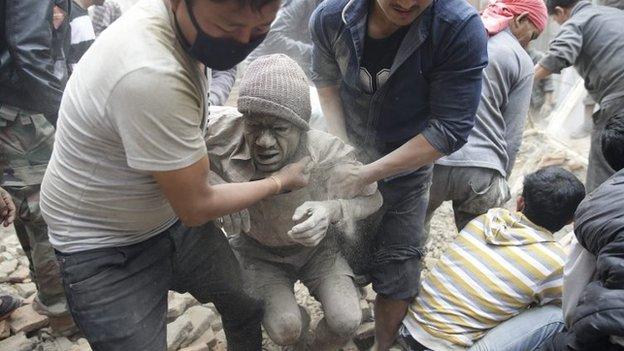Nepal quake 'followed historic pattern'
- Published
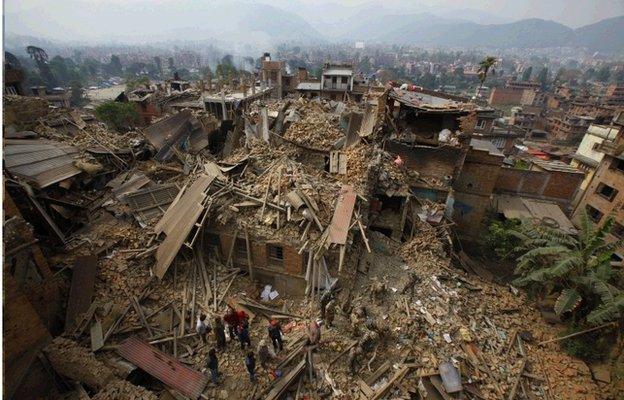
A sadly prescient turn of events: Geologists uncovered historic connections only weeks ago
Nepal's devastating magnitude-7.8 earthquake on Saturday was primed over 80 years ago by its last massive earthquake in 1934, which razed around a quarter of Kathmandu to the ground and killed over 17,000 people.
This latest quake follows the same pattern as a duo of big tremors that occurred over 700 years ago, and results from a domino effect of strain transferring along the fault, geologists say.
The researchers discovered the likely existence of this doublet effect only in recent weeks, during field work in the region.
Saturday's quake, which struck an area in central Nepal, between the capital Kathmandu and the city of Pokhara, has had a far-reaching impact.
More than 4,000 people have lost their lives, with victims in Bangladesh, India, Tibet, and on Mount Everest, where avalanches were triggered.
Death tolls and casualty figures are likely to rise over the coming days, and the risk of landslides on slopes made unstable by the quake mean that the danger is far from passed.
Trench investigations
In a sadly prescient turn of events, Laurent Bollinger, external, from the CEA research agency in France, and his colleagues, uncovered the historical pattern of earthquakes during fieldwork in Nepal last month, and anticipated a major earthquake in exactly the location where Saturday's big tremor has taken place.
Down in the jungle in central southern Nepal, Bollinger's team dug trenches across the country's main earthquake fault (which runs for more than 1,000km from west to east), at the place where the fault meets the surface, and used fragments of charcoal buried within the fault to carbon-date when the fault had last moved.
Ancient texts mention a number of major earthquakes, but locating them on the ground is notoriously difficult.
Monsoon rains wash soils down the hillsides and dense jungle covers much of the land, quickly obscuring earthquake ruptures.
Bollinger's group was able to show that this segment of fault had not moved for a long time.
"We showed that this fault was not responsible for the great earthquakes of 1505 and 1833, and that the last time it moved was most likely 1344," says Bollinger, who presented his findings to the Nepal Geological Society, external two weeks ago.
Previously, the team had worked on the neighbouring segment of fault, which lies to the east of Kathmandu, and had shown that this segment experienced major quakes in 1255, and then more recently in 1934.

The deadly pattern of quakes around Kathmandu
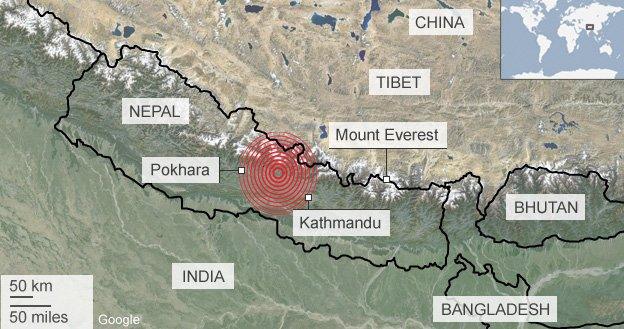
Saturday's magnitude-7.8 earthquake struck to the north-west of Kathmandu
The last time the fault ruptured at this location was back in 1344
It was preceded in 1255 by a big event to the east of Kathmandu
The last rupture there was in 1934, hinting strain might accumulate westward
2015's quake follows the pattern with a gap between events of 80 years or so

When Bollinger and his colleagues saw this historic pattern of events, they became greatly concerned.
"We could see that both Kathmandu and Pokhara would now be particularly exposed to earthquakes rupturing the main fault, where it likely last did in 1344, between the two cities," explains Paul Tapponnier, from the Earth Observatory of Singapore, external, who was working with Bollinger.
When a large earthquake occurs, it is common for the movement to transfer strain further along the earthquake fault, and this seems to be what happened in 1255.
Over the following 89 years, strain accumulated in the neighbouring westerly segment of fault, finally rupturing in 1344.
Now, history has repeated itself, with the 1934 fault transferring strain westwards along the fault, which has finally been released today, 81 years later.
And, worryingly, the team warns there could be more to come.
"Early calculations suggest that Saturday's magnitude-7.8 earthquake is probably not big enough to rupture all the way to the surface, so there is still likely to be more strain stored, and we should probably expect another big earthquake to the west and south of this one in the coming decades," says Bollinger.
- Published25 April 2015
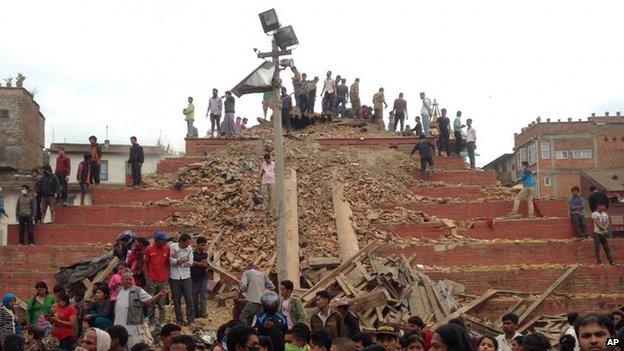
- Published26 April 2015
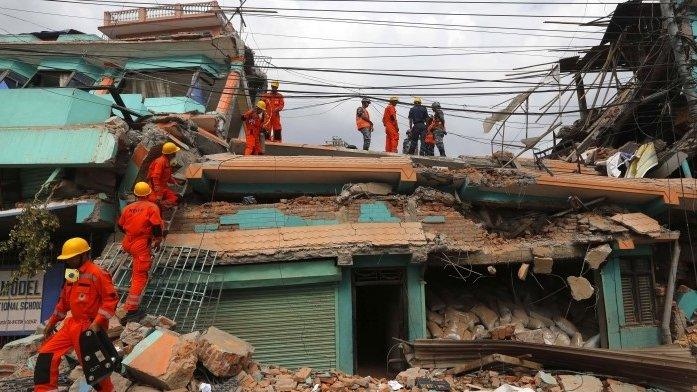
- Published25 April 2015
